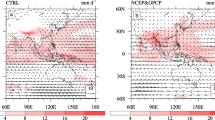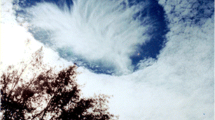Abstract
The National Center for Atmospheric Research Community Atmosphere Model (version 3.5) coupled with the Morrison–Gettelman two-moment cloud microphysics scheme is employed to simulate the aerosol effects on clouds and precipitation in two numerical experiments, one representing present-day conditions (year 2000) and the other the pre-industrial conditions (year 1750) over East Asia by considering both direct and indirect aerosol effects. To isolate the aerosol effects, we used the same set of boundary conditions and only altered the aerosol emissions in both experiments. The simulated results show that the cloud microphysical properties are markedly affected by the increase in aerosols, especially for the column cloud droplet number concentration (DNC), liquid water path (LWP), and the cloud droplet effective radius (DER). With increased aerosols, DNC and LWP have been increased by 137% and 28%, respectively, while DER is reduced by 20%. Precipitation rates in East Asia and East China are reduced by 5.8% and 13%, respectively, by both the aerosol’s second indirect effect and the radiative forcing that enhanced atmospheric stability associated with the aerosol direct and first indirect effects. The significant reduction in summer precipitation in East Asia is also consistent with the weakening of the East Asian summer monsoon, resulting from the decreasing thermodynamic contrast between the Asian landmass and the surrounding oceans induced by the aerosol’s radiative effects. The increase in aerosols reduces the surface net shortwave radiative flux over the East Asia landmass, which leads to the reduction of the land surface temperature. With minimal changes in the sea surface temperature, hence, the weakening of the East Asian summer monsoon further enhances the reduction of summer precipitation over East Asia.








Similar content being viewed by others
References
Albrecht BA (1989) Aerosols, cloud microphysics, and fractional cloudiness. Science 245:1227–1230
Breon FM, Tanre D, Generoso S (2002) Aerosol effect on cloud droplet size monitored from satellite. Science 295:834–838
Cheng YJ, Lohmann U, Zhang JH, Luo YF, Liu ZT, Lesins G (2005) Contribution of changes in sea surface temperature and aerosol loading to the decreasing precipitation trend in southern China. J Climate 18:1381–1390
Collins WD, Rasch PJ, Boville BA, Hack JJ, McCaa JR, Williamson DL, Kiehl JT, Briegleb B, Bitz C, Lin SJ, Zhang M, Dai Y (2004) Description of the NCAR Community Atmosphere Model (CAM 3.0). NCAR Tech. Note NCAR/TN-464 + STR, 226 pp
Dentener F, Kinne S, Bond T, Boucher O, Cofala J, Generoso S, Ginoux P, Gong S, Hoelzemann JJ, Ito A, Marelli L, Penner JE, Putaud J-P, Textor C, Schulz M, van der Werf GR, Wilson J (2006) Emissions of primary aerosol and precursor gases in the years 2000 and 1750 prescribed data-sets for AeroCom. Atmos Chem Phys 6:4321–4344, http://www.atmos-chem-phys.net/6/4321/2006/
Ding YH, Wang ZY (2008) A study of rainy seasons in China. Meteorol Atmos Phys 100:121–138
Ding YH, Sun Y, Wang ZY, Zhu YX, Song YF (2009) Inter-decadal variation of the summer precipitation in China and its association with decreasing Asian summer monsoon Part II: possible causes. Intern J Climatol 29:1926–1944
Duan J, Mao JT (2009) Influence of aerosol on regional precipitation in North China. Chin Sci Bull 54:474–483
Emmons LK, Walters S, Hess PG, Lamarque JF, Pfister GG, Fillmore D, Granier C, Guenther A, Kinnison D, Laepple T, Orlando J, Tie X, Tyndall G, Wiedinmyer C, Baughcum SL, Kloster S (2010) Description and evaluation of the Model for Ozone and Related Chemical Tracers, version 4 (MOZART-4). Geosci Model Dev 3:43–67
Fu CB, Ma ZG (2008) Global change and regional aridification. Chin J Atmos Sci 32:752–760 (in Chinese)
Gent P, Bader D, Bonan G et al. (2009) Community Earth System Model Science Plan: 2009–2015. Available from http://www.ccsm.ucar.edu
Gettelman A, Morrison H (2008) A new two-moment bulk stratiform cloud microphysics scheme in the community atmosphere model, Version 3 (CAM3). Part II: single-column and global results. J Climate 21:3660–3679
Giorgi F, Bi X, Qian Y (2002) Direct radiative forcing and regional climatic effects of anthropogenic aerosols over East Asia: a regional coupled climate-chemistry/aerosol model study. J Geophys Res 107(D20):4439. doi:10.1029/2001JD001066
Giorgi F, Bi X, Qian Y (2003) Indirect vs. direct climatic effects of anthropogenic sulfate over East Asia as simulated with a regional coupled climate-chemistry/aerosol model. Clim Change 58:345–376
Gu Y, Liou KN, Xue Y, Mechoso CR, Li W, Luo Y (2006) Climatic effects of different aerosol types in China simulated by the UCLA general circulation model. J Geophys Res 111:D15201. doi:10.1029/2005JD006312
Gu Y, Liou KN, Chen W, Liao H (2010) Direct climate effect of black carbon in China and its impact on dust storms. J Geophys Res 115:D00K14. doi:10.1029/2009JD013427
Guo QY (1983) The summer monsoon intensity index in East Asia and its variation. Acta Ceographica Sinica 38:207–217 (in Chinese)
Hu ZZ, Yang S, Wu R (2003) Long-term climate variations in China and global warming signals. J Geophys Res 108(D19):4614. doi:10.1029/2003JD003651
Huang Y, Chameides WL, Dickinson RE (2007) Direct and indirect effects of anthropogenic aerosols on regional precipitation over east Asia. J Geophys Res 112:D03212. doi:10.1029/2006JD007114
Intergovernmental Panel on Climate Change (IPCC) (2007) Climate change 2007: the physical science Basis: Working Group I Contribution to the Fourth Assessment Report of the IPCC (AR4). WMO and UNEP. Cambridge University Press, Valencia, Spain
Khairoutdinov M, Kogan Y (2000) A new cloud physics parameterization in a large-eddy simulation model of marine stratocumulus. Mon Weather Rev 128:229–243
Kiehl JT, Gent PR (2004) The Community Climate System Model, version 2. J Climate 17:3666–3682
Kinne S et al (2006) An AeroCom initial assessment—optical properties in aerosol component modules of global models. Atmos Chem Phys 6:1815–1834
Lau KM, Kim KM (2006) Observational relationships between aerosol and Asian monsoon rainfall, and circulation. Geophys Res Lett 33:L21810. doi:10.1029/2006GL027546
Lau KM, Kim MK, Kim KM (2006) Asian summer monsoon anomalies induced by aerosol direct forcing: the role of the Tibetan Plateau. Climate Dyn 26:855–864
MA ZG (2007) The interdecadal trend and shift of dry/wet over the central part of North China and their relationship to the Pacific Decadal Oscillation (PDO). Chin Sci Bull 52:2130–2139
Massie ST, Torres O, Smith SJ (2004) Total Ozone Mapping Spectrometer (TOMS) observations of increases in Asian aerosol in winter from 1979 to 2000. J Geophys Res 109:D18211. doi:10.1029/2004JD004620
Meehl GA, Arblaster JM, Collins WD (2008) Effects of black carbon aerosols on the Indian monsoon. J Climate 21:2869–2882
Menon S, Hansen J, Nazarenko L, Luo Y (2002) Climate effects of black carbon aerosols in China and India. Science 297:2250–2253
Morrison H, Gettelman A (2008) A new two-moment bulk stratiform cloud microphysics scheme in the community atmosphere model, Version 3 (CAM3). Part I: description and numerical tests. J Climate 21:3642–3659
Penner JE, Dong XQ, Chen Y (2004) Observational evidence of a change in radiative forcing due to the indirect aerosol effect. Nature 427:231–234
Qian Y, Leung LR, Ghan SJ, Giorgi F (2003) Regional climate effects of aerosols over China: modeling and observation. Tellus Ser B 55:914–934
Qian WH, Lin X, Zhu YF, Xu Y, Fu JL (2007) Climatic regime shift and decadal anomalous events in China. Clim Change 84:167–189
Qian Y, Gong D, Fan J, Leung LR, Bennartz R, Chen D, Wang W (2009) Heavy pollution suppresses light rain in China: observations and modeling. J Geophys Res 114:D00K02. doi:10.1029/2008JD011575
Quaas J, Ming Y, Menon S et al (2009) Aerosol indirect effects—general circulation model intercomparison and evaluation with satellite data. Atmos Chem Phys 9:8697–8717
Ramanathan V, Crutzen PJ, Kiehl JT, Rosenfeld D (2001) Aerosol, climate and the hydrological cycle. Science 294:2119–2124
Ramanathan V, Chung C, Kim D, Bettge T, Buja L, Kiehl JT, Washington WM, Fu Q, Sikka DR, Wild M (2005) Atmospheric brown clouds: impacts on South Asian climate and hydrological cycle. Proc Natl Acad Sci USA 102:5326–5333
Ramanathan V, Ramana MV, Roberts G et al (2007) Warming trends in Asia amplified by brown cloud solar absorption. Nature 448:575–578
Remer LA, Kleidman RG, Levy RC et al. (2008) Global aerosol climatology from the MODIS satellite sensors. J Geophys Res 113(D14S07). DOI: 10.1029/2007JD009661
Rosenfeld D, Lohmann U, Raga GB et al (2008) Flood or drought: how do aerosols affect precipitation? Science 321:1309–1313
Sud YC, Wilcox E, Lau WKM, Walker GK, Liu XH, Nenes A, Lee D, Kim KM, Zhou Y, Bhattacharjee PS (2009) Sensitivity of boreal-summer circulation and precipitation to atmospheric aerosols in selected regions—part 1: Africa and India. Ann Geophys 27:3989–4007
Twomey S (1974) Pollution and the planetary albedo. Atmos Environ 8:1251–1256
Webster PJ (1987) The elementary monsoon. In: Fein JS, Stephens PL (eds) Monsoons. Wiley, New York, pp 3–32
Wu J, Fu CB, Xu YY, Tang JP, Han ZW, Zhang RJ (2009) Effects of total aerosol on temperature and precipitation in East Asia. Clim Res 40:75–87
Xu Q (2001) Abrupt change of the mid-summer climate in central East China by the influence of atmospheric pollution. Atmos Environ 35:5029–5040
Zhang H, Wang ZL, Guo PW, Wang ZZ (2009) A modeling study of the effects of direct radiative forcing due to carbonaceous aerosol on the climate in East Asia. Adv Atmos Sci 26:57–66
Zhao C, Tie X, Lin Y (2006) A possible positive feedback of reduction of precipitation and increase in aerosols over eastern central China. Geophys Res Lett 33:L11814. doi:10.1029/2006GL025959
Zhou TJ, Yu RC, Li HM, Wang B (2008) Ocean forcing to changes in global monsoon precipitation over the recent half-century. J Climate 21:3833–3852
Acknowledgments
This work was supported by China Special Fund for Nonprofit Organizations (GYHY200706036), National Basic Research Program of China (2011CB403406), CAS Science and Technology Specific Project (XDA05110101) and NSFC (40825008).
Author information
Authors and Affiliations
Corresponding author
Rights and permissions
About this article
Cite this article
Liu, X., Xie, X., Yin, ZY. et al. A modeling study of the effects of aerosols on clouds and precipitation over East Asia. Theor Appl Climatol 106, 343–354 (2011). https://doi.org/10.1007/s00704-011-0436-6
Received:
Accepted:
Published:
Issue Date:
DOI: https://doi.org/10.1007/s00704-011-0436-6




